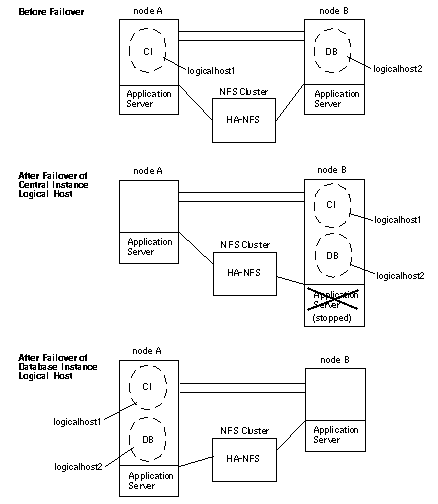Supported Configurations
See your Enterprise Services representative for the most current information about supported SAP versions. More information on each configuration type is provided in the following sections.
Two-Node Cluster With One Logical Host
The simplest SAP cluster configuration is a two-node cluster with one logical host, as illustrated in Figure 1-1. In this asymmetric configuration, the SAP central instance and database instance (collectively called the central system), are both placed on one node. NFS is also be placed on the same node. This configuration is relatively easy to configure and administer. A drawback is that the backup node is underutilized. In case of failover, the central instance, database instance, and NFS service are switched to the backup node.
Figure 1-1 Asymmetric SAP Configuration

Two-Node Cluster With One Logical Host and Development or Test SystemIn this configuration, the central system (the central instance and database instance) is placed on one node and a development or test system is placed on a backup node. The development or test system remains running until a failover of the logical host moves the central system to the backup node. This scenario is illustrated in Figure 1-2. In this configuration, you must customize the Sun Cluster HA for SAP hasap_stop_all_instances script such that the development or test system is shut down before the SAP central instance is switched over and brought up. See the hasap_stop_all_instances(1M) man page and "Configuration Options for Application Servers and Test/Development Systems" for more information.
Figure 1-2 Asymmetric SAP Configuration With Development or Test System

Two-Node Cluster With One Logical Host, Application Servers, and Separate NFS Cluster
You can also place SAP application servers on one or both physical hosts. In this configuration, you must provide NFS services from a host outside the cluster. Set up the application servers to NFS-mount the file systems from the external NFS cluster, as illustrated in Figure 1-3. In case of failover, the logical host containing the central system (the central instance and database instance) switches to the backup node. The application servers do not migrate with the logical host, but are instead started or shut down depending on where the logical host is mastered. This prevents the application servers from competing for resources with the central instance and database.
Figure 1-3 Asymmetric SAP Configuration With Application Servers and External HA-NFS

Two-Node Cluster With Two Logical Hosts
A two-node cluster with two logical hosts can be configured with the SAP central instance on one logical host and the SAP database instance on the other logical host, as illustrated in Figure 1-4. In this configuration, the nodes are load-balanced and both are utilized. In case of failover, the central instance or database instance is switched to the sibling node.
Figure 1-4 Symmetric SAP Configuration With Two Logical Hosts

Two-Node Cluster With Two Logical Hosts, Application Servers, and Separate NFS Cluster
A two-node cluster with two logical hosts can be configured with SAP application servers on one or both physical hosts. In this configuration, you must provide NFS services from a host outside the cluster. Set up the application servers to NFS-mount the file systems from the external NFS cluster, as illustrated in Figure 1-5. In this case, both nodes are utilized and load-balanced.
In case of failover, the logical hosts switch over to the sibling node. The application servers do not fail over.
If the central instance logical host fails over, the application server can be shut down through the hasap_stop_all_instances script.
There are no customizable scripts to start and stop application servers in case of failover of the database logical host. If the database logical host fails over, the application servers cannot be shut down to release resources for the database logical host. Therefore, you must size your configuration to allow for the possible scenario in which the central instance, database instance, and application server are all running on the same node simultaneously.
In this configuration, NFS is protected by Sun Cluster HA for NFS. For more information, see "Sun Cluster HA for NFS Considerations".
Figure 1-5 Symmetric SAP Configuration With Two Logical Hosts and Application Servers

- © 2010, Oracle Corporation and/or its affiliates
